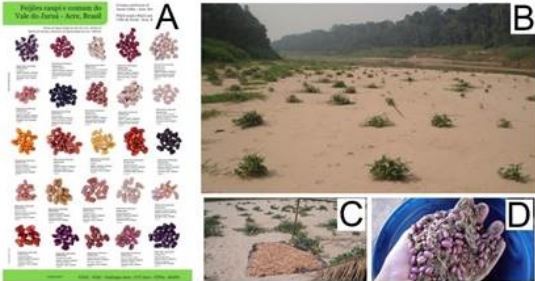Traditional method of storing cowpea grains and seeds for insect-pest control
Main Article Content
Abstract
This work aimed to evaluate the efficiency of traditional method of storage of cowpea grains and seeds for the control of the Callosobruchus maculatus (Fabr.) (Coleoptera: Bruchidae). The storage method consists of packing grains and seeds, mixed with threshing residue, in hermetically sealed polyethylene bottles or barrels. In the experiment, four treatments were evaluated: (i.) Perforated flask containing grains, (ii.) Non-perforated flask containing grains, (iii.) Perforated flask containing a mixture of grains and threshing residues and (iv.) Non-perforated bottle containing a mixture of grains and threshing residues, the latter representing the traditional method (control). For each treatment, 4 replicates were used. For each pot, 20 adult individuals of the insect-pest were inserted. After induced infestation, the pots were stored in a place protected from rain and sun, simulating the reality of farmers' storage. At 35 and 70 days after the induced infestation, the following variables were counted for each pot: number of live insects, number of dead insects, number of holes caused by insects in the grains and percentage of grains attacked. The use of threshing residue was not efficient for the control. On the other hand, the absence of gas exchange in the pot decreased the multiplication of the insect pest, indicating the importance of using hermetic barrels ourvacuum packaging for storage and commercialization.
Article Details

This work is licensed under a Creative Commons Attribution-NonCommercial 4.0 International License.
Those authors who have publications with this journal accept the following terms of the License Attribution-NonCommercial 4.0 International (CC BY-NC 4.0):
You are free to:
- Share — copy and redistribute the material in any medium or format
- Adapt — remix, transform, and build upon the material
The licensor cannot revoke these freedoms as long as you follow the license terms.
Under the following terms:
- Attribution — You must give appropriate credit, provide a link to the license, and indicate if changes were made. You may do so in any reasonable manner, but not in any way that suggests the licensor endorses you or your use.
- NonCommercial — You may not use the material for commercial purposes.
- No additional restrictions — You may not apply legal terms or technological measures that legally restrict others from doing anything the license permits.
The journal is not responsible for the opinions and concepts expressed in the works, they are the sole responsibility of the authors. The Editor, with the assistance of the Editorial Committee, reserves the right to suggest or request advisable or necessary modifications. They are accepted to publish original scientific papers, research results of interest that have not been published or sent to another journal for the same purpose.
The mention of trademarks of equipment, instruments or specific materials is for identification purposes, and there is no promotional commitment in relation to them, neither by the authors nor by the publisher.
References
Kébé K, Alvarez N, Tuda M, Arnqvist G, Fox CW, Sembène M, et al. Global phylogeography of the insect pest Callosobruchus maculatus (Coleoptera: Bruchinae) relates to the history of its main host, Vigna unguiculata. Journal of Biogeography. 2017;44(11):2515-2526. doi: 10.1111/jbi.13052.
CABI Invasive Species Compendium. Wallingford, UK: CAB International. 2020. Available from: http://www.cabi.org/isc. 2020.
Mattar EPL, Oliveira E de, Jesus JC da S, Araújo ML de, Siviero A, Santos Junior HC dos. Creolo beans production systems in Juruá valley, Acre, Brazilian Amazon. Indian Journal of Traditional Knowledge. 2016;15(4):619-624.
Mattar EPL, Oliveira E de, Jesus JC da S, Araújo ML de, Nagy ACG. Colheita e secagem. En: Mattar EPL, Oliveira, E de; Santos, RC dos; Siviero, A (Org.). Feijões do Vale do Juruá. IFAC; 2017 p. 217-222, Rio Branco, Brazil.
Primavesi A. Manejo ecológico de pragas e doenças: técnicas alternativas para a produção agropecuária e defesa do meio ambiente. São Paulo, Brazil: Expressão Popular.; 2016. 144 p.
Prakash, BG, Raghavendra K V, Gowthami R, Shashank R. Indigenous practices for eco-friendly storage of food grains and seeds. Adv Plants Agric Res. 2016;3(4):101-107. doi: 10.15406/apar.2016.03.00101.
Lawrence B, Bicksler AJ, Duncan K. Local treatments and vacuum sealing as novel control strategies for stored seed pests in the tropics. Agron. Sustain. Dev. 2017;37(6). doi: 10.1007/s13593-017-0415-0. Available from: https://link.springer.com/content/pdf/10.1007/s13593-017-0415-0.pdf
Duarte AF. Aspectos da climatologia do Acre, Brasil, com base no intervalo 1971 - 2000. Revista Brasileira de Meteorologia. 2006;21(3b):308-317.
R Development Core Team R: A language and environment for statistical computing. R Foundation for Statistical Computing, Vienna, Áustria, 2016. Available from: http://www.R-project.org
Silva MGC, Silva GN, Sousa AH, Freitas RS, Silva MSG, Abreu AO. Hermetic storage as an alternative for controlling Callosobruchus maculatus (Coleoptera: Chrysomelidae) and preserving the quality of cowpeas. Journal of Stored Products Research. 2018;78:27-31. doi: 10.1016/j.jspr.2018.05.010
Njoroge AW, Mankin RW, Smith BW, Baributsa D. Oxygen consumption and acoustic activity of adult Callosobruchus maculatus (F.) (Coleoptera: Chrysomelidae: Bruchinae) during hermetic storage. Insects. 2018;9(2):45. doi:10.3390/insects9020045. Available from: https://www.ncbi.nlm.nih.gov/pmc/articles/PMC6023381/pdf/insects-09-00045.pdf
Daglish GJ, Jagadeesan R, Nayak MK. Temperature-dependent development and reproduction of the cowpea weevil, Callosobruchus maculatus F., in mungbean: Estimating a target temperature for its control using aeration cooling. Journal of Stored Products Research. 2021;92. doi: 10.1016/j.jspr.2021.101815. Available from: https://www.sciencedirect.com/science/article/pii/S0022474X21000540
Kumar S, Mohapatra D, Kotwaliwale N, Singh KK. Vacuum Hermetic Fumigation: A review. Journal of Stored Products Research. 2017;71:47-56. doi: 10.1016/j.jspr.2017.01.002
Barbosa FR, Yokoyama M., Pereira PAA, Zimmermann FJP. Controle do caruncho-do-feijoeiro Zabrotes subfasciatus com óleos vegetais, munha, materiais inertes e malathion. Pesq. agropec. bras. 2002;37(9):1213-1217. doi: 10.1590/S0100-204X2002000900002
Alecio MR, Fazolin M, Coelho Netto RA, Catani V, Estrelas JLV, Alves SB, et al. Ação inseticida do extrato de Derris amazónica Killip para Cerotoma arcuatus Olivier (Coleoptera: Chrysomelidae. Acta Amaz. 2010;40(4):719-728. doi: 10.1590/S0044-59672010000400012.
